Spatial-Heterogeneity Analysis of the Heavy Metals Cd and Pb in Road Dust in the Main Urban Area of Harbin
Abstract
:1. Introduction
2. Materials and Methods
2.1. Study Site
2.2. Sample Collection and Determination
2.3. Data Processing
2.4. Spatial-Correlation Analysis
2.5. Spatial-Variability Analysis
3. Results
3.1. Classical Statistical Analysis of Heavy-Metal Content in Road Dust in the Main Urban Area of Harbin
3.2. Spatial Correlation Analysis
3.2.1. Global Moran’s I
3.2.2. Anselin Local Moran’s I
3.3. Spatial-Variability Analysis
3.3.1. Data Pre-Processing
3.3.2. Structural Characteristics of Heavy Metals in Dust
3.4. Spatial-Interpolation Analysis
3.4.1. Cross-Validation and Trend Analysis
3.4.2. Heavy-Metal Spatial-Interpolation Method Results
4. Discussion
5. Conclusions
- (1)
- The average value of the heavy metals Cd and Pb in road dust in Harbin was greater than the background value of Heilongjiang province, and the content of Cd exceeded the GB15618-2018 soil-pollution-risk screening value. These findings indicated that there was a certain degree of Cd and Pb pollution in the main urban area of Harbin, with Cd pollution being relatively serious. Both Cd and Pb exhibited moderate variation, with coefficients of variation of 40.96% and 30.00%, respectively.
- (2)
- The Cd in the study area was weakly correlated in space and randomly distributed; the Pb was spatially moderately correlated and had a good spatial structure. The two heavy metals were spatially clustered, Cd and Pb had high-value clusters, and Pb had low-value clusters. The semivariance functions indicated that the theoretical optimal model for Cd was spherical, whereas that for Pb was exponential. The nugget coefficients for the two were 88.6% (Cd) and 74.4% (Pb), indicating that the variation of Cd was mainly influenced by human factors. In addition, the variation of Pb was mainly influenced by both natural and human factors.
- (3)
- The high-value areas of the dust’s heavy-metal elements in the study area are mainly located near the junction of Daoli District and Xiangfang District–Xidazhang Street, and the pollution in the east is more serious than that in the west. The spatial distribution of Cd was elliptical, and the distribution of Pb was stripe-shaped. The high-value areas of Cd in the study area are mainly influenced by human activities, including vehicle-exhaust emissions and tire wear caused by dense transportation networks, dense distribution of factories, atmospheric deposition, and road paint. In addition to Pb, there were also natural factors influenced by the sediments of the Songhua River. Otherwise, the area might have naturally high levels of heavy metals due to geological processes. According to the estimated probability results, there was a high-potential risk of Cd in the northeastern part of the study area. Therefore, it is necessary to strengthen road cleaning and implement strict management systems, such as restricting vehicle travel during specific periods for areas with high values of heavy metals, and not to slack off for areas with low values of heavy metals and to do a good job of prevention and management.
Author Contributions
Funding
Institutional Review Board Statement
Informed Consent Statement
Data Availability Statement
Acknowledgments
Conflicts of Interest
References
- Chang, J.; Liu, M.; Hou, L.J.; Xu, S.Y.; Lin, X.; Ballo, S. Concept, pollution character and environmental effect of urban surface dust. Chin. J. Appl. Ecol. 2007, 18, 1153–1158. [Google Scholar]
- Banerjee, A.D.K. Heavy metal levels and solid phase speciation in street dusts of Delhi, India. Environ. Pollut. 2003, 123, 95–105. [Google Scholar] [CrossRef]
- Sun, Y.; Zhou, Q.; Xie, X.; Liu, R. Spatial, sources and risk assessment of heavy metal contamination of urban soils in typical regions of Shenyang, China. J. Hazard. Mater. 2009, 174, 455–462. [Google Scholar] [CrossRef] [PubMed]
- Zhang, X.; Yu, X.; Song, Q.; Sun, L.; Du, B.; Chen, W. Characteristics and health risk assessment of heavy metals in PM10 and PM2.5 at the south coast of Xiamen Bay. Environ. Sci. Technol. 2019, 42, 201–210. [Google Scholar] [CrossRef]
- Han, Y.; Cao, J.; Posmentier, E.S.; Fung, K.; Tian, H.; An, Z. Particulate-associated potentially harmful elements in urban road dusts in Xi’an, China. Appl. Geochem. 2007, 23, 835–845. [Google Scholar] [CrossRef]
- Shi, D.; Lu, X.; Xu, X.; Han, X. Study on heavy metal pollution and sources of suspended dust on roads in Baotou city. Environ. Sci. Technol. 2019, 42, 16–23. [Google Scholar] [CrossRef]
- Yu, X.; Li, F.; Fu, G.; Feng, H.; Xiong, F. Evaluation of spatial and temporal distribution characteristics and pollution level of heavy metals in road dust in Beijing. Mod. Geol. 2019, 33, 169–175. [Google Scholar] [CrossRef]
- Tian, H.; Yang, L.; Xia, Z.; Ning, S.; Wei, C. Distribution characteristics of heavy metals in surface particulate matter and ecological risk evaluation in Lintong District, Xi’an City. J. Ecol. Environ. 2018, 27, 276–281. [Google Scholar] [CrossRef]
- Jiao, W.; Niu, Y.; Li, B.; Duan, Y.; Zhang, N.; Zhao, Y.; Niu, Y. Health risk evaluation and anthropogenic source analysis of heavy metals from urban road dust based on chemical morphology analysis. J. Ecol. Environ. 2018, 27, 2269–2275. [Google Scholar] [CrossRef]
- Zhu, L.; Chen, Y.Y.; Yuan, G.J.; Zhang, X.Y.; Jiang, X.Q.; Yang, X.R.; Wang, X.H. Optimal evaluation of ecological risk of heavy metals in urban road sediments. Environ. Sci. Res. 2022, 35, 836–844. [Google Scholar] [CrossRef]
- Shahab, A.; Hui, Z.; Rad, S.; Xiao, H.; Siddique, J.; Huang, L.L.; Ullah, H.; Rashid, A.; Taha, M.R.; Zada, N. A comprehensive review on pollution status and associated health risk assessment of human exposure to selected heavy metals in road dust across different cities of the world. Environ. Geochem. Health 2022, 1–22. [Google Scholar] [CrossRef] [PubMed]
- Guo, B.; Su, Y.; Pei, L.; Wang, X.; Zhang, B.; Zhang, D.; Wang, X. Ecological risk evaluation and source apportionment of heavy metals in park playgrounds: A case study in Xi’an, Shaanxi Province, a northwest city of China. Environ. Sci. Pollut. Res. 2020, 27, 24400–24412. [Google Scholar] [CrossRef] [PubMed]
- Qin, Z.; Shi, H.; Wang, M.; Bai, Z.; Yang, Z.; Hao, Y. Spatial distribution and correlation of soil Cd pollution in the main tributaries of Xiangjiang River basin. Environ. Sci. Res. 2018, 31, 1399–1406. [Google Scholar] [CrossRef]
- Li, C.; Ou, X.; Zhang, C.; Yang, H.; Zeng, J.; Li, N.; Li, S. Analysis of heavy metal pollution and spatial variability of farmland soils along the Huanjiang River. J. Jiangxi Agric. Univ. 2018, 40, 1348–1356. [Google Scholar] [CrossRef]
- Chandra, R.; Prusty, B.; Azeez, P.A. Spatial variability and temporal changes in the trace metal content of soils: Implications for mine restoration plan. Environ. Monit. Assess. 2014, 186, 3661–3671. [Google Scholar] [CrossRef] [PubMed]
- Zhang, K.; He, J.; Zhong, Y.; Wei, Q.; Chen, F. GIS-based analysis of heavy metal sources in soils around a copper-silver mining area in Ningxia. Environ. Sci. 2022. [Google Scholar] [CrossRef]
- Liu, Z.; Fei, Y.; Shi, H.; Mo, L.; Qi, J.; Wang, C. Analysis of soil heavy metal sources in Rucheng County, Hunan Province based on UNMIX model and Moran index. Environ. Sci. Res. 2021, 34, 2446–2458. [Google Scholar] [CrossRef]
- Yu, J.; Shi, H.; Wang, M.; Liu, X. Identification of soil heavy metal cadmium pollution sources in the impact area of key polluting enterprises in Xiangjiang sub-basin. Environ. Sci. Res. 2020, 33, 1013–1020. [Google Scholar] [CrossRef]
- Chen, Y. Spatial autocorrelation theory development and method improvement based on Moran statistics. Geogr. Res. 2009, 28, 1449–1463. [Google Scholar]
- Li, C.; Liu, C. Spatial correlation and variation analysis of soil Cd around enterprises in Ful River basin. In Proceedings of the 2021 Annual Scientific and Technical Conference of the Chinese Society of Environmental Science—Environmental Engineering Technology Innovation and Application Session (II), Tianjin, China, 20–21 October 2021; pp. 358–364. [Google Scholar] [CrossRef]
- Nielsen, D.R.; Warrick, A.W.; Myers, D.E. Geostatistical Methods Applied to Soil Science. Methods Soil Anal. 1986, 5, 53–82. [Google Scholar]
- Zhang, H.; Zhao, K.; Ye, Z.; Xu, B.; Zhao, W.; Gu, X.; Zhang, H. Spatial heterogeneity of soil heavy metals and its risk evaluation in typical pecan production areas. Environ. Sci. 2018, 39, 2893–2903. [Google Scholar] [CrossRef]
- State Environmental Protection Administration; China National Environmental Monitoring Station. Chinese Soil Element Background Values; China Environmental Science Publishing: Beijing, China, 1990.
- 15618—2018 G; Soil Environmental Quality Agricultural Land Soil Pollution Risk Control Standard. Ministry of Ecology and Environment of the People’s Republic of China: Beijing, China, 2018.
- Cheng, H.; Li, K.; Li, M.; Yang, K.; Liu, F.; Cheng, X. Background and benchmark values of soil chemical elements in Chinese cities. Geol. Foreground 2014, 21, 265–306. [Google Scholar] [CrossRef]
- Zheng, F.; Guo, X.; Tang, M.; Zhu, D.; Dong, S.; Kang, L.; Chen, B. Distribution characteristics and ecological risk assessment of heavy metals in Baiyangdian and surrounding soils. Environ. Sci. 2022. [Google Scholar] [CrossRef]
- Zhang, J.; Li, X.; Zhang, L.; Yang, K.; Zhang, Q.; Wang, Y. Spatial variability and sources of heavy metal elements in potentially selenium-rich soils at Brick Bridge, Lujiang County, Anhui Province, China. Environ. Sci. Res. 2019, 32, 1594–1603. [Google Scholar] [CrossRef]
- Yang, M.H.; Wang, W.L.; Jin, Z.H.; Zhang, J. Study on the spatial variability of heavy metals in surface dust in urban areas of Baoji City. Henan Sci. 2021, 39, 1317–1323. [Google Scholar]
- Huang, S.; Fang, B.; Li, X.; He, S. Study on spatial heterogeneity of soil alkaline dissolved nitrogen in rice fields based on county scale. J. Ecol. Rural. Environ. 2020, 36, 179–185. [Google Scholar] [CrossRef]
- Jiao, S. Spatial Heterogeneity Analysis of Soil Heavy Metal Pollution Based on PXRF. Master’s Thesis, Nanjing Forestry University, Nanjing, China, 2021. [Google Scholar] [CrossRef]
- Zhang, L.; Chen, X.; Zhang, Z. Analysis of spatial variability of water chemistry in a southwestern karst watershed. Earth Environ. 2019, 47, 594–600. [Google Scholar] [CrossRef]
- Wang, M.; Dong, J.; Bai, L.; Zhang, Y.; Jiang, Z.; Jiang, N.; Wu, J.; Zhang, L.; Fang, J.; Fu, W. Spatial heterogeneity of soil heavy metals and their ecological risks in the main production areas of Cephalotaxus botrytis in Zhejiang Province. Environ. Sci. 2021, 42, 5949–5957. [Google Scholar] [CrossRef]
- Yang, N.; Lian, Y.; Xia, X.; Zhang, M.S.; Li, Z. Study on spatial variability and multivariate homogeneity partitioning of soil heavy metals in a typical region. J. Agric. Environ. Sci. 2021, 40, 1451–1459. [Google Scholar]
- Liu, M. Study on the Pattern of Spatial Heterogeneity of Soil Heavy Metals in Small Watersheds of Black Soil Area. Master’s Thesis, Northeast Agricultural University, Harbin, China, 2021. [Google Scholar] [CrossRef]
- ESRI. Using Geostatistical Analyst; ESRI Inc.: Redlands, CA, USA, 2004. [Google Scholar]
- Shen, R. Analysis of Spatial Variability of Organic Matter Content in Different Types of Soils in Datong City. Master’s Thesis, Shanxi Agricultural University, Jinzhong, China, 2019. [Google Scholar] [CrossRef]
- Zhao, K.; Fu, W.; Ye, Z.; Dai, W. Spatial heterogeneity and distribution characteristics of soil heavy metals in electronic waste dismantling area. Environ. Sci. 2016, 37, 3151–3159. [Google Scholar] [CrossRef]
- Ma, J.; Gu, L.; Li, W. Heavy metal accumulation and potential risk in the roadside soil of Zheng-Shang section of Lian-Huo Expressway. Environ. Sci. 2009, 30, 894–899. [Google Scholar] [CrossRef]
- Zhu, M.; Tang, L.; Liu, D. A review of soil heavy metal monitoring and assessment along traffic arteries. China Environ. Monit. 2015, 31, 84–91. [Google Scholar] [CrossRef]
- Geng, Y.; Zhang, C.; Zhang, Y.; Huang, D.; Yan, S.; Sun, T.; Cheng, L.; Wang, J.; Mao, Y. Fugacity patterns and ecological risk assessment of heavy metals in urban sludge in China. Environ. Sci. 2021, 42, 4834–4843. [Google Scholar] [CrossRef]
- Li, Y.; Ma, J.; Liu, D.; Sun, Y.; Chen, Y. Evaluation of heavy metal pollution and potential ecological risk in Kaifeng urban soil. Environ. Sci. 2015, 36, 1037–1044. [Google Scholar] [CrossRef]
- Dong, C.Y.; Zhang, W.G.; Wang, G.; Ma, H.L.; Liu, R.Y.; Liu, Y.; Ye, L.P.; Yu, L.C. Isotopic discrimination of urban soil lead pollution sources in Baoshan District, Shanghai. Environ. Sci. 2012, 33, 754–759. [Google Scholar] [CrossRef]
- Li, Z. Study on the Evaluation of Heavy Metal Content, Morphology and Ecological Risk of Surface Sediments in Songhua River. Master’s Thesis, Lanzhou University of Technology, Lanzhou, China, 2019. [Google Scholar]
- Gao, C.; Zhang, K.; Zang, S.; Zhang, L.; Sun, L. Analysis of air pollutant transport pathways and potential source areas in Harbin City. Environ. Sci. Technol. 2021, 44, 162–170. [Google Scholar] [CrossRef]
- Jeong, H.; Choi, J.Y.; Lim, J.; Shim, W.J.; Kim, Y.O.; Ra, K. Characterization of the contribution of road deposited sediments to the contamination of the close marine environment with trace metals: Case of the port city of Busan (South Korea). Mar. Pollut. Bull. 2020, 161, 111717. [Google Scholar] [CrossRef]
- Guan, Y.; Lai, Z.; Li, X.; Wang, S.; Zhang, Y.; Zhao, J.; Zhou, J. Determination of Pb, Cd, Cr(III) and Cr(VI) in paints and inks. Anal. Test Tech. Instrum. 2015, 21, 32–36. [Google Scholar] [CrossRef]
- Lv, J. Quantitative source analysis and spatial prediction of soil heavy metals in Yantai coastal zone. J. Geogr. 2021, 76, 713–725. [Google Scholar]
- Liu, Y.; Ma, Z.; Lu, J.; Bi, J. Analysis of soil heavy metal sources and environmental risk assessment in Rizhao city. J. Geogr. Sci. 2016, 26, 735–749. [Google Scholar] [CrossRef] [Green Version]

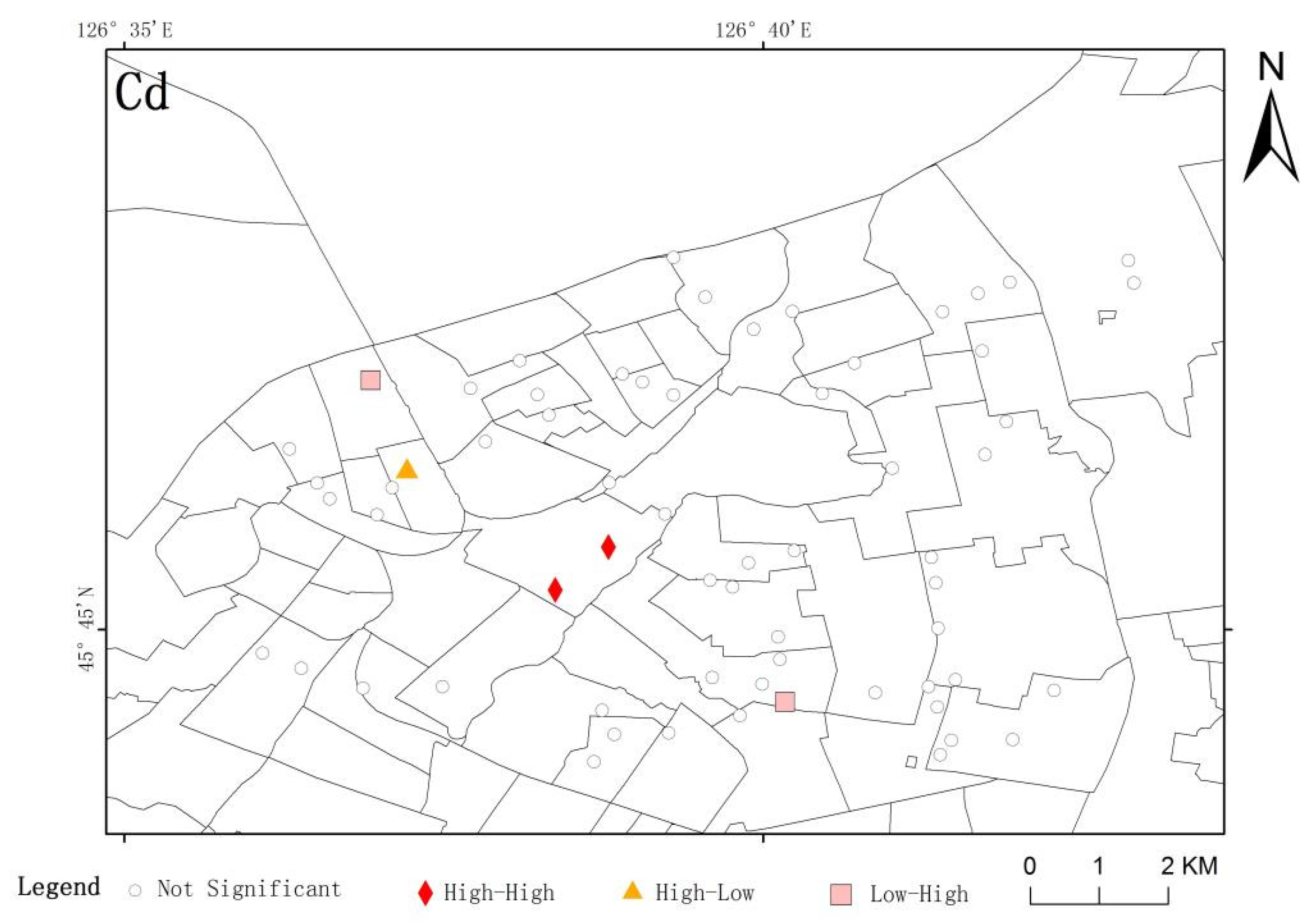


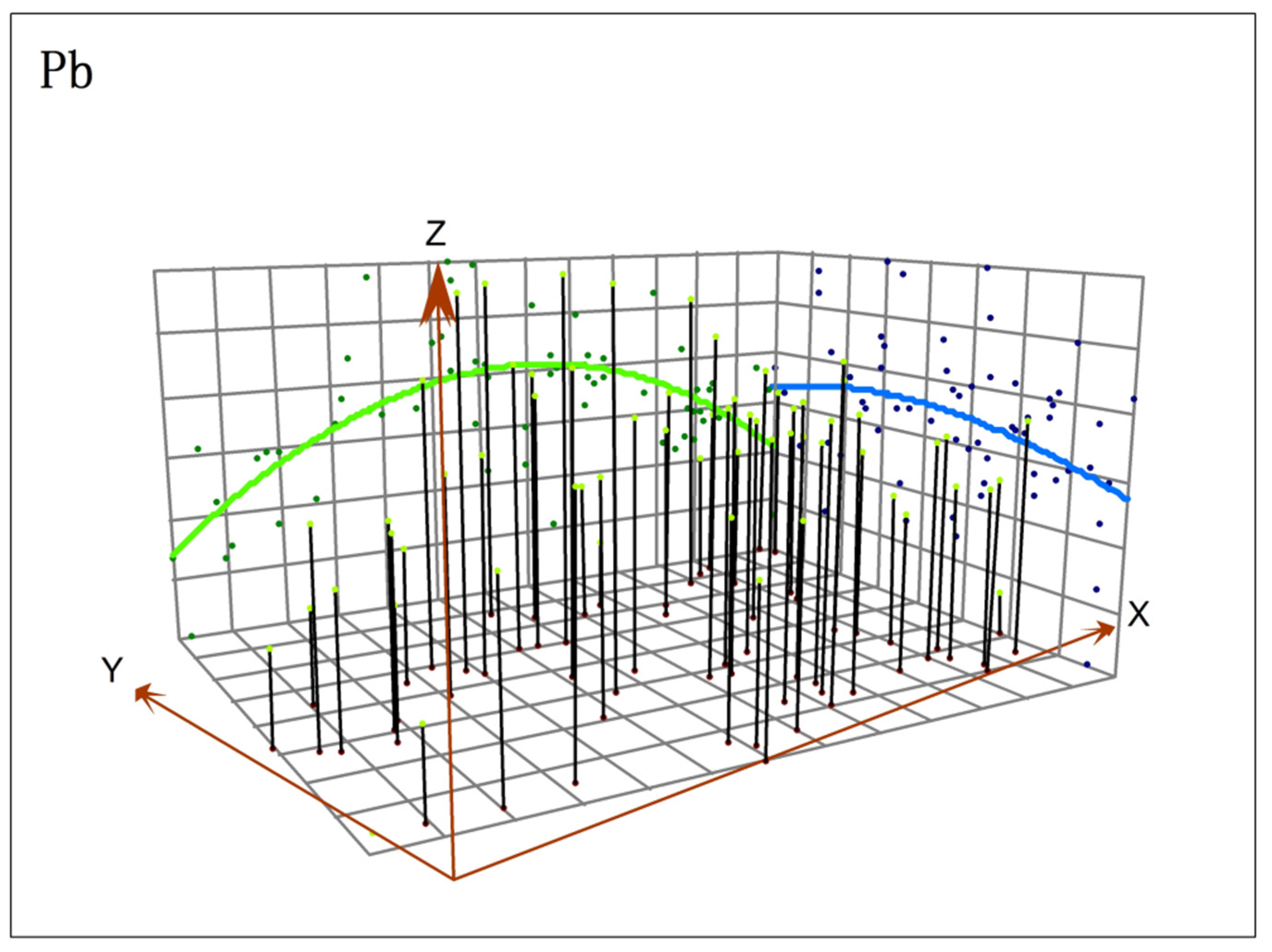
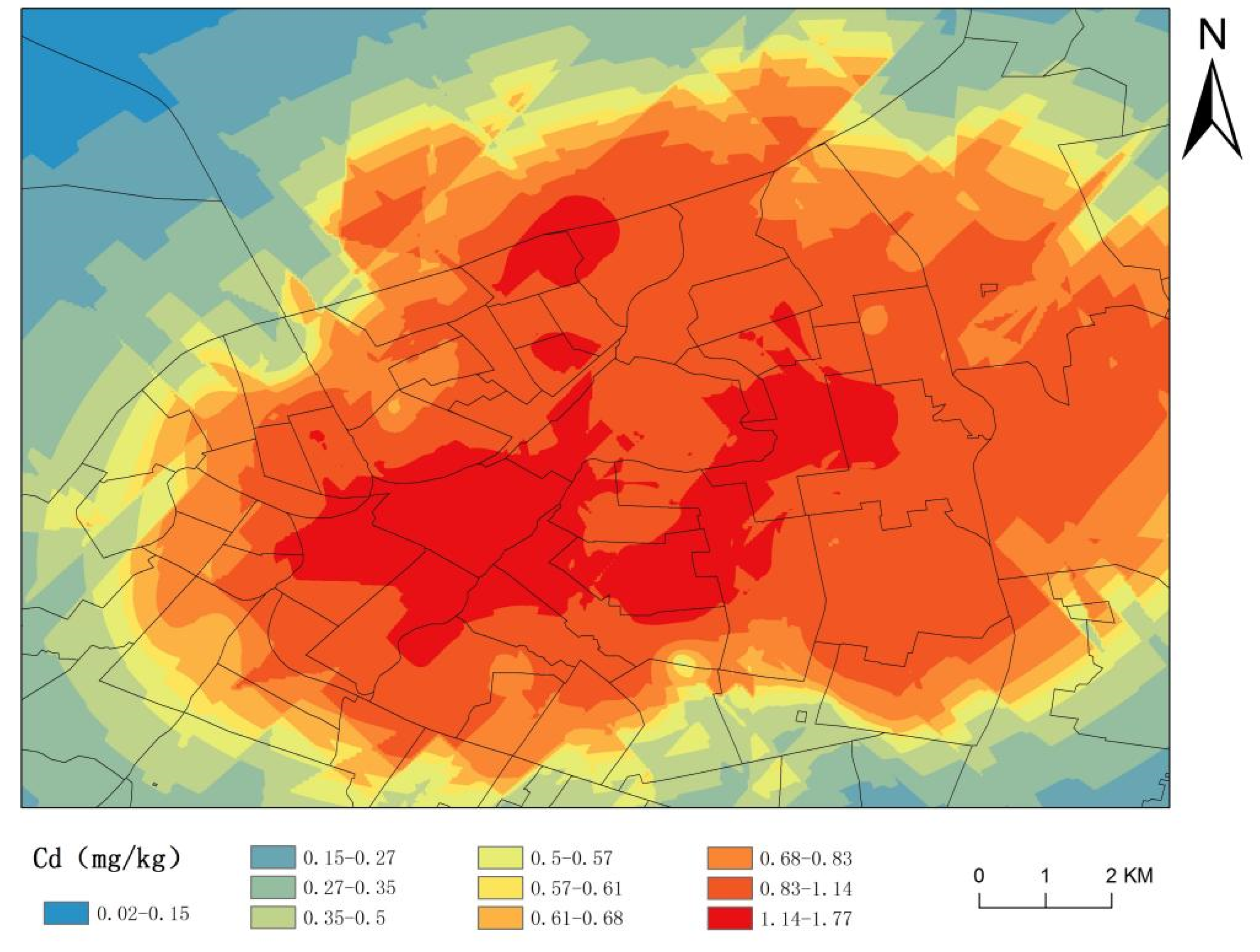

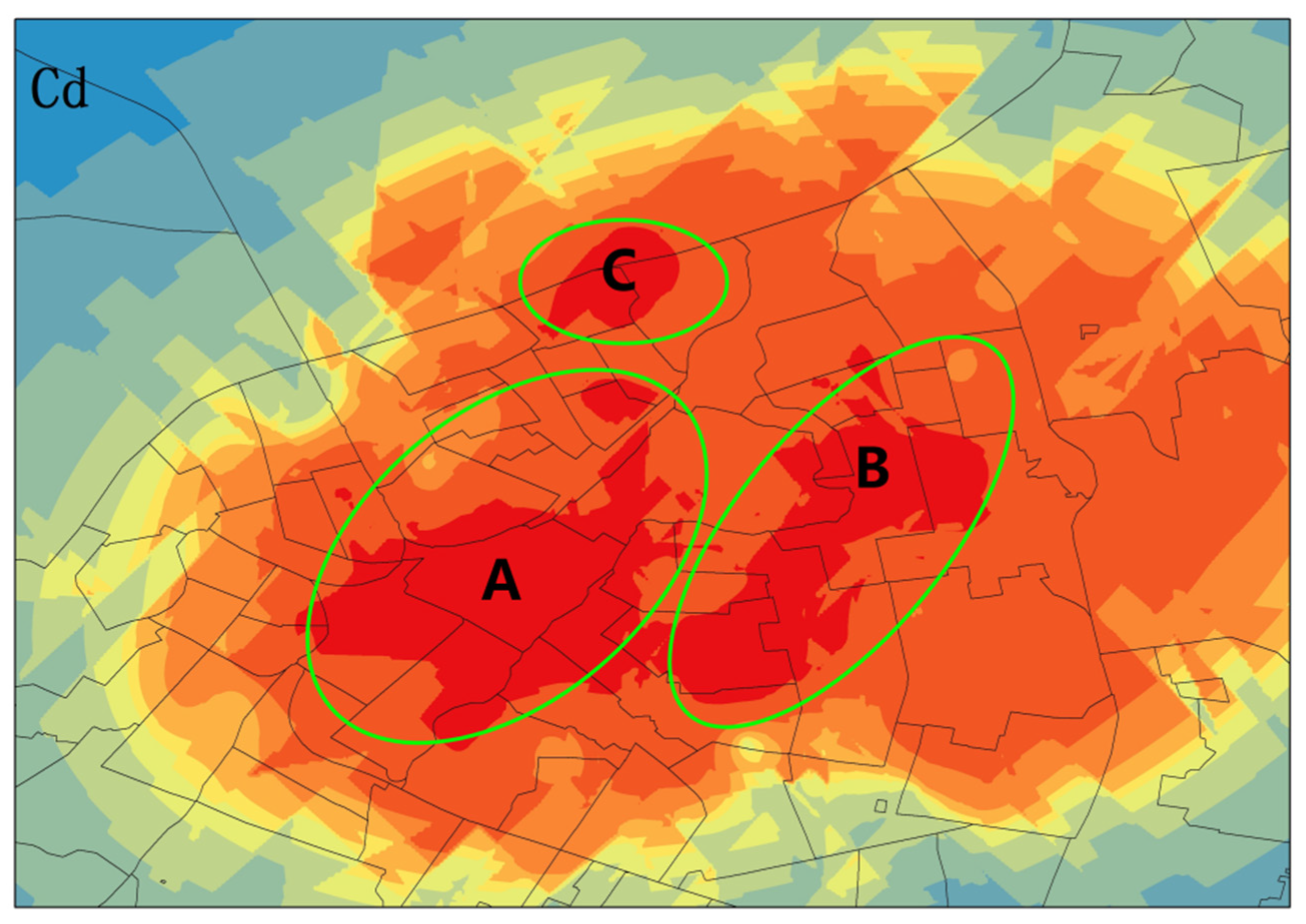

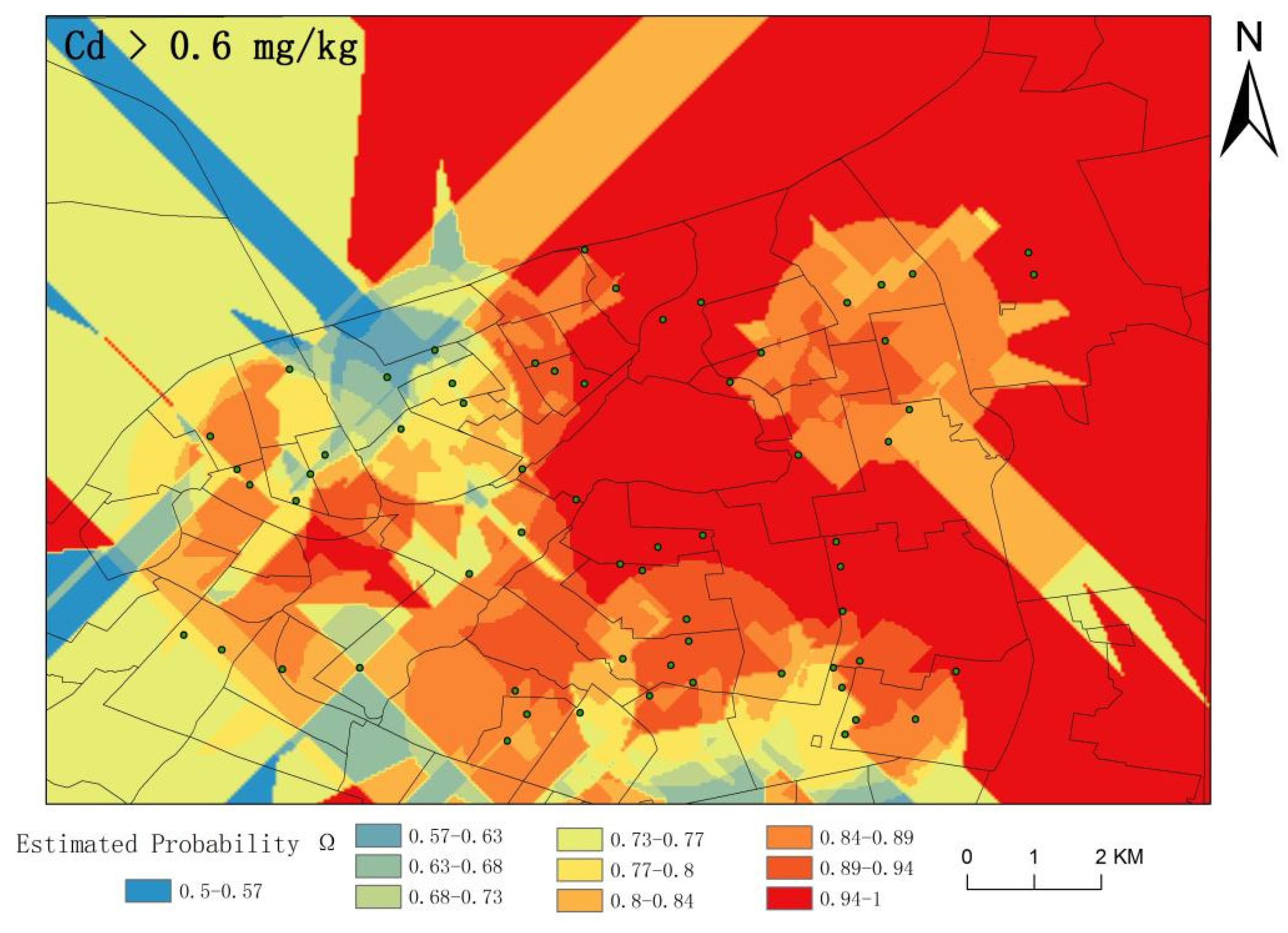
| Elements | Max | Min | Mean | Median | SD | CV | Background 1 | Excess Rate |
|---|---|---|---|---|---|---|---|---|
| Cd (mg/kg) | 2.23 | 0.12 | 0.96 | 0.93 | 0.39 | 40.96% | 0.08 | 87.30% |
| Pb (mg/kg) | 132.00 | 16.00 | 81.14 | 82.00 | 23.77 | 30.00% | 22.00 | 1.59% |
| PH | 9.31 | 6.62 | 7.83 | 7.66 | 0.62 | 7.89% | 8.00 | - 2 |
| Element | Moran’s I | Z Value | p-Value | Correlation |
|---|---|---|---|---|
| Cd | 0.175 | 1.882 | 0.060 | Weak |
| Pb | 0.351 | 3.568 | 0.000 | Moderate |
| Element | p-Value | Transformed p-Value | Probability Distributions |
|---|---|---|---|
| Cd | 0.004 | 0.200 | Normal distribution |
| Pb | 0.200 | No transformed | Normal distribution |
| Element | Model | C0 | C0 + C | Range | C0/(C0 + C) | R2 | RSS |
|---|---|---|---|---|---|---|---|
| Cd | Spherical | 0.020 | 0.176 | 1260 m | 0.886 | 0.785 | 1.848 × 10−3 |
| Pb | Exponential | 180 | 703.800 | 8220 m | 0.744 | 0.931 | 13,674 |
| Element | ME | MSE | RMSSE |
|---|---|---|---|
| Cd | −0.011 | −0.023 | 1.029 |
| Pb | 0.053 | −0.001 | 1.119 |
Publisher’s Note: MDPI stays neutral with regard to jurisdictional claims in published maps and institutional affiliations. |
© 2022 by the authors. Licensee MDPI, Basel, Switzerland. This article is an open access article distributed under the terms and conditions of the Creative Commons Attribution (CC BY) license (https://creativecommons.org/licenses/by/4.0/).
Share and Cite
Cheng, Z.; Xu, S.; Na, X.; Zhang, X.; Ma, D.; Zhang, P. Spatial-Heterogeneity Analysis of the Heavy Metals Cd and Pb in Road Dust in the Main Urban Area of Harbin. Sustainability 2022, 14, 8007. https://doi.org/10.3390/su14138007
Cheng Z, Xu S, Na X, Zhang X, Ma D, Zhang P. Spatial-Heterogeneity Analysis of the Heavy Metals Cd and Pb in Road Dust in the Main Urban Area of Harbin. Sustainability. 2022; 14(13):8007. https://doi.org/10.3390/su14138007
Chicago/Turabian StyleCheng, Zhiying, Siruo Xu, Xueying Na, Xujia Zhang, Dalong Ma, and Peng Zhang. 2022. "Spatial-Heterogeneity Analysis of the Heavy Metals Cd and Pb in Road Dust in the Main Urban Area of Harbin" Sustainability 14, no. 13: 8007. https://doi.org/10.3390/su14138007
APA StyleCheng, Z., Xu, S., Na, X., Zhang, X., Ma, D., & Zhang, P. (2022). Spatial-Heterogeneity Analysis of the Heavy Metals Cd and Pb in Road Dust in the Main Urban Area of Harbin. Sustainability, 14(13), 8007. https://doi.org/10.3390/su14138007




